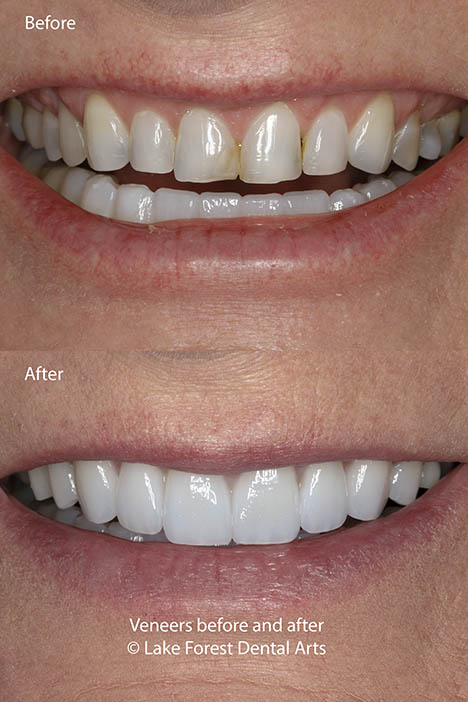
Do you often find yourself dreaming of a brighter or more beautiful smile? Do you frequently wish your teeth looked better, or that you had a different smile altogether? If so, you may have considered cosmetic dentistry but hesitated because you were unsure what the best way to go. Serving as a cosmetic dentist for 2 decades, we have found that many problems can be addressed with either cosmetic bonding or veneers without drilling. Many clients don’t know which choice is better for them, veneers vs bonding.
Both cosmetic procedures can create far more beautiful, yet still natural looking smiles. To determine which treatment is right for you, talk with your dentist about your goals for your smile!
What Issues Are You Hoping To Address?
When choosing between veneers vs bonding, look at your issues. Unless your only issue is teeth staining, the dentist may recommend either bonding or veneers for enhancing your smile. That is because both can help hide a variety of cosmetic concerns. If you have really small or large teeth, oddly shaped teeth, minor gaps between teeth and permanent or intrinsic discoloration.
How Does Bonding Work?
As mentioned earlier, porcelain veneers or cosmetic bonding can both address the same issues. It doesn’t matter if the teeth are too small, misshapen, or have jagged edges, stains, or minor gaps between the teeth. Using bonding material, you can be finished in one day. Bonding is less expensive. It can create almost as esthetic a result as veneers. While porcelain veneers are designed to create even longer-lasting results thanks to porcelain’s stain resistance and strength, bonding offers as number of benefits all its own.
Some of the unique benefits of choosing bonding include:
- Cosmetic bonding is one of the fastest cosmetic treatments available. In fact, most dentists can complete bonding in an hour or two.
- That is because bonding is completed by skillfully sculpting a composite resin material onto the teeth. It can be used to create a more symmetrical, brighter and more beautiful smile.
- A thin layer of bonding material can effectively address several cosmetic issues at once. Only veneers are another way to do that.
 What Can Veneers Do for You?
What Can Veneers Do for You?
- Veneers are a durable way to address a slew of cosmetic concerns, quickly. Learn more about caring for the dental porcelain in your veneers and crowns.
- Modern veneers require very little or no preparation of your existing teeth. Heavy filing of natural teeth enamel is no longer necessary to properly fit a patient with veneers. Technological advances in ceramics allow veneers now be made incredibly thin. In fact, some veneers come in no-prep options, which require no tooth preparation!
- Veneers can correct the same cosmetic problems that cosmetic bonding can. They are more dependable for problems that are located under the tissue. They are also better at treating discolored teeth. Often old composite veneers are replaced with porcelain.
- Veneers are made to match your existing teeth’s shade and contouring. The resulting enhancements that veneers create are natural-looking and nearly seamless with the rest of your smile.
- Proper dental care, including preventive dental checkups, makes it possible to preserve veneers for more than a decade. This makes veneers one of the longest lasting forms of cosmetic treatment available.
Choosing veneers vs bonding depends on the goals for treatment.
Though both dental bonding and porcelain veneers can effectively hide many of the same concerns, they do have unique benefits and a few disadvantages as well. In order to determine which is the better solution for your smile, talk to your dentist. Inform the dentist about your budget considerations and how quickly you hope to have the enhancements completed. Lastly, share how long you expect them to last.
Here are a few cosmetic dental considerations:
- Cosmetic bonding is an affordable and fast treatment option, thanks to the dentist’s own artistry being used to create the enhancements. The composite resin material used to craft the improvements is durable, but less stain-resistant than the porcelain used to create veneers.
- Veneers are more expensive initially than bonding, but they can create more long-lasting results because veneers are naturally stain resistant. Most people can enjoy their veneers for ten to 20 years, or even more, so long as they use excellent dental hygiene and maintain preventive care. Poor hygiene can cause odor problems with veneers.
- Dentists will choose to use veneers for a smile makeover of more than 4 teeth because they will have more control.
- Significantly changing contours can create difficulty in keeping clean. Poorly cleaned veneers can cause your breath to smell.
Confused as to which is better, dental bonding vs porcelain veneers?
The old adage, less is better usually applies to dentistry. If your problem can be fixed with bonding, then that is best. If a front tooth is involved and the restoration is covering the entire tooth, then veneers are better.
Dr. Fondriest is a Nationally recognized and highly sought after cosmetic dentist. He serves clients from throughout the United States

 What Can Veneers Do for You?
What Can Veneers Do for You?